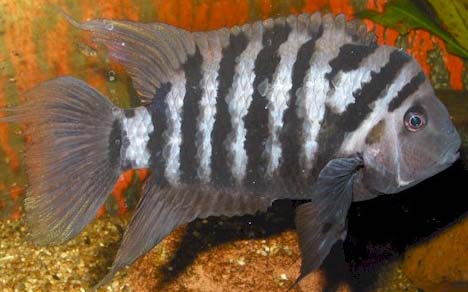The
Convict Cichlid
By Alex (Devil)

Photo © Aquaworld
Scientific
name: Archocentrus nigrofasciatus
Introduction: This cichlid is from Central America, it is a well known cichlid
in Central America for its ease to reproduce and is quite a prolific breeder,
and also, demand for exact water quality is not needed with Convicts,
as they can tolerate vast amounts of pH levels and water hardness. They
are white with black stripes, and they have a black area around the head.
There relatively small size does not call for a large aquarium.
Living conditions:
pH: Not important but avoid extremes.
Water hardness: As above, no extremes.
Temperature: 26-28 Degrees Celsius.
Water changes: 25% every two weeks.
Food: Brine shrimp nauplii, bloodworms, water fleas,
flakes, mussels, shrimps
Compatibility: Avoid submissive species.
Comments: The convict’s colours are not as colourful
as they are in the wild.
Life in the aquarium: The
convict is very easy to keep; it adapts very easily to water changes and
is not as prone to disease as other fish. To keep it happy, decorate the
aquarium with rocks and roots to provide hiding places. A tank of 100
liters is enough to keep a pair of convicts. You will need an aquarium
of around 250 liters if you plan on having other fish in with it, as it
can be a very aggressive species at times.
Breeding: The reproduction of this fish is very easy, have a pair in a
tank of around 80 liters; you will not need any plants but have some rocks
and some caves. Feed the parents on frozen, freeze dried and live food
such as blood worms and brine shrimps.
The female will pick a dark cave, after she has picked
a cave she will court the male, the eggs will be laid on a clean rock
and the couple will carefully guard the eggs, this is when they can get
very aggressive, any intruder will be chased off and they can cause serious
injury to the intruders, that’s why its better to keep them by themselves
when they breed. The eggs will hatch after three days, but the fry will
have a few more days to absorb the yolk sac which contains food for them,
after they have finished it, they will start free swimming in huge numbers,
the parents still keep a close eye for any predators. Spawns can be anywhere
from 100 to 200 fry, and the parents will most likely have another batch
two weeks after. If they are kept in a community tank, the young will
search for food, but will most likely get eaten by the other fish in the
tank, this can’t be stopped, and only a few will live to mature.
Feeding the
babies: Feed the babies brine shrimp nauplii during the first
few weeks and gradually switch to flakes or finely crushed food, with
a blend of finely shrimps, mussels and spinach.
|







